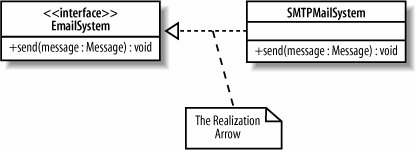Section 5.4. Interfaces
5.4. InterfacesIf you want to declare the methods that concrete classes should implement, but not use abstraction since you have only one inheritance relationship (if you're coding in Java), then interfaces could be the answer. An interface is a collection of operations that have no corresponding method implementationsvery similar to an abstract class that contains only abstract methods. In some software implementation languages, such as C++, interfaces are implemented as abstract classes that contain no operation implementations. In newer languages, such as Java and C#, an interface has its own special construct.
Think of an interface as a very simple contract that declares, "These are the operations that must be implemented by classes that intend to meet this contract." Sometimes an interface will contain attributes as well, but in those cases, the attributes are usually static and are often constants. See Chapter 4 for more on the use of static attributes. In UML, an interface can be shown as a stereotyped class notation or by using its own ball notation, as shown in Figure 5-15. Figure 5-15. Capturing an interface to an EmailSystem using the stereotype and "ball " UML notation; unlike abstract classes, an interface does not have to show that its operations are not implemented, so it doesn't have to use italics If you were implementing the EmailSystem interface from Figure 5-15 in Java, then your code would look like Example 5-7. Example 5-7. The EmailSystem interface is implemented in Java by using the interface keyword and contains the single send(..) operation signature with no operation implementation
You can't instantiate an interface itself, much like you can't instantiate an abstract class. This is because all of the implementations for an interface's operations are missing until it is realized by a class. If you are using the "ball" interface notation, then you realize an interface by associating it with a class, as shown in Figure 5-16. Figure 5-16. The SMTPMailSystem class implements, or realizes, all of the operations specified on the EmailSystem interface If you have used the stereotype notation for your interface, then a new arrow is needed to show that this is a realization relationship , as shown in Figure 5-17. Figure 5-17. The realization arrow specifies that the SMTPMailSystem realizes the EmailSystem interface Both Figures 5-16 and 5-17 and would have resulted in the same Java code being generated, as shown in Example 5-8. Example 5-8. Java classes realize interfaces using the implements keyword
If a class realizes an interface but does not implement all of the operations that the interface specifies, then that class needs to be declared abstract, as shown in Figure 5-18. Figure 5-18. Because the SMTPMailSystem class does not implement the send(..) operation as specified by the EmailSystem interface, it needs to be declared abstract; the VendorXMailSystem class completes the picture by implementing all of its operations Interfaces are great at completely separating the behavior that is required of a class from exactly how it is implemented. When a class implements an interface, objects of that class can be referred to using the interface's name rather than the class name itself. This means that other classes can be dependent on interfaces rather than classes. This is generally a good thing since it ensures that your classes are as loosely coupled as possible. If your classes are loosely coupled, then when a class implementation changes other classes should not break (because they are dependent on the interface, not on the class itself).
|
EAN: 2147483647
Pages: 175
